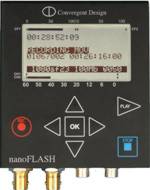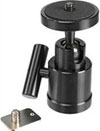|
Convergent Design NanoFlash - HD Portable
Recorder/Player (Discontinued)
|
| |
|

Product Code: Nano
Flash
Click here for large picture
|
NanoFlash
Accessory
|
|

Hot Shoe mount for nanoFlash
(CD-NF_001)

|
|
| Basic NanoFlash Kit |
NanoFlash Kit Bundle 1 |
NanoFlash Kit
Bundle 2 |
|
The kit
consists of:
1. nanoFlash
2. AC Power
Supply
|
The kit 1 consists of:
1.nanoFlash recorder & player
2.Hotshoe Ball Mount
3.18" SDI Cable
4.18" D-Tap Cable
5.HDMI Cable
6.AC Power Supply
7.USB 2.0 CompactFlash Card Reader
|
The kit
2 consists of:
1.nanoFlash recorder & player
2.Hotshoe Ball Mount
3.18" SDI Cable
4.HDMI Cable
5.AC Power Supply
6.USB 2.0 CompactFlash Card Reader
7.Battery Pouch / Battery Holder
8.Two 2-Cell Lithium-Ion Batteries 9.Battery Charger
(In this Bundle D-Tap Cable Not Included)
|
| |
|
|
CompactFlash
HD/SD SDI and HDMI Recorder/Player
nanoFlash is the world’s smallest, lightest, lowest-power,
professional HD/SD recorder/player
Easily mounted to your camera, nanoFlash is designed to record
higher quality images than the camera itself, by capturing
never-compressed video/audio from the HD-SDI or HDMI output.
nanoFlash utilizes the very high-quality Sony XDCAM 422 CODEC,
recording the video/audio onto affordable Compact Flash Media, at
visually lossless rates up to 160Mbps (Long-GOP) or 220 Mbps
(I-Frame). The footage can be stored in either Quicktime (MOV),
MXF, or MPG file formats, providing near-universal NLE support as
well as DVD / Blu-Ray authoring formats.
 
Convergent Design nanoFlash The
images are recorded in 4:2:2 in CF card
|
Applications/benefits of nanoFlash
a. To upgrade the video/audio quality of your existing camera:
1. 4:2:0 → 4:2:2 (color)
2. 1440x1080 → 1920x1080
(full-raster)
3. 25/35 Mbps → 50/100/140/160/220
Mbps (bit-rate)
4. Compressed 16-bit audio →
Uncompressed 24-bit audio
b. Tapeless Workflow
c. Enhance recording capabilities of your camera with pre-record
buffer, pull-down removal, interval recording, redundant recording,
etc.
d. Presentations, Trade Shows, Theme Parks, Museums, Libraries,
etc.
e. Client / Feature Production Review
f. Helicopters, Race Cars, Airplanes, Jets, and other high
vibration applications
g. Weather balloons, underwater footage
h. Portable HD/SD recorder for switcher output
i. POV camera recorder
j. Video Assist
k. Field Recorder
l. Review Footage on any HDTV or HD-SDI or HDMI Monitor
m. Real-time DVD / Blu-Ray Encoding (.mpg file)
Will nanoFlash
work with my camera?
If your camera has an HD/SD-SDI or HDMI output with a compatible
format, then the answer is yes. Some popular cameras include:
a. Sony PMW-EX1, PMW-EX1R, PMW-EX3, PMW-EX350, F900, XDCAM HD,
HVR-S270, HVR-Z5, HVR-Z7
b. Canon XL-H1s, G1, HV20, HV30, HV40, HFs10, HFs11
c. Iconix HD RH1
d. Hitachi HV-HD30, DK-H32
e. Ikegami HDL-2
f. JVC GY-HD250, GY-HD251, GY-HM100, GY-M700
g. Panasonic HPX170, HPX500, HPX-900, HPX-300, GP-US932
h. Toshiba IK-HD1, IK-HR1D, IK-HR1H, IK-HR1S
i. Thomson Viper
j. Vision Research Phantom Cameras (HD-SDI output)
k. Wige Cumina Camera
l. Easy Look Systems Cameras
Will nanoFlash
improve the image quality of my existing
camera?
Three major components largely determine the ultimate video quality
from your camera: the lens, the CCD/CMOS sensor, and the built-in
recorder. Some cameras do offer interchangeable lenses, so you may
have the option to upgrade over the standard issue. The CCD/CMOS
sensor is fixed on all cameras and cannot be modified. However, all
HD-SDI and HDMI cameras allow users to upgrade the recording
subsystem, which can yield significant improvement at reasonable
costs. It’s really quite simple, but let’s first
discuss the problem with your built-in recorder.
Your camera’s recording subsystem has two major components:
the CODEC and the storage device. The CODEC compresses the video
from about 1,200 Mbps (uncompressed HD) to a more manageable 20 to
220 Mbps. The storage device is typically a tape, optical disk, or
possibly a memory card. Compressed video, along with audio and
timecode, is stored on these media for playback or transfer to a
NLE.

The CODEC and storage medium are both significant in determining
your video quality. In general, the higher the compressed bit-rate,
the better the video quality. However, most storage media severely
restrict the possible data-rates. Mini-DV tape (used in HDV
cameras), for example, has a fixed read/write bandwidth about 25
Mbps; SDHC memory cards are limited to about 45 Mbps. So, the
ultimate data-rate from the CODEC must be restricted to match the
performance of the storage medium.
The level of sophistication and implementation of the CODEC play a
major role as well. I-Frame only CODECs, in general, require two to
three times the bit-rate to equal the quality of the more
sophisticated Long-GOP CODECs. (100 Mbps I-Frame is roughly
equivalent to 35 Mbps Long-GOP in overall quality). Most CODECs,
(HDV, DVCPro HD, XDCAM EX, and even HDCAM) also reduce the
potential quality through color-sample decimation (4:2:2 →
4:2:0 or 3:1:1) and/or by horizontally sub-sampling (1920 →
1440 or 1920 → 1280).
The Solution: nanoFlash - High-Bit Rate,
Full-Raster, 4:2:2
The nanoFlash overcomes these quality-robbing restrictions in your
camera. You connect to the HD/SD-SDI or HDMI camera output (in live
mode) to send “never-compressed” video directly from
the CCD/CMOS sensor to the high-quality CODEC and then to the
high-speed digital storage (CompactFlash cards) in the
nanoFlash.
Since nanoFlash records on CompactFlash solid-state memory, (as
opposed to tape, optical disk or SDHC cards) the bit-rate can be
substantially increased over your built-in recorder.
nanoFlash features a sophisticated high-quality Sony XDCAM 4:2:2
(MPEG2) CODEC with data-rates up to 160 Mbps in Long-GOP mode
(I,P,B Frames), and up to 220 Mbps in I-Frame-only mode. The CODEC
compresses the video without reducing the color sampling (full
4:2:2) and without sub-sampling the horizontal data (full
1920).
So what does full-raster (1920), full-color (4:2:2), high-bit rate
(100+ Mbps), compression produce? Well, in independent tests, the
results are clear: images that are visually indistinguishable from
the uncompressed HD-SDI / HDMI images directly out of your camera!
So, nanoFlash can vastly improve on the weakest link in the quality
chain: your camera’s built-in recorder.
|
|
| Why Nano Flash
Recorder? |
|
1.Enable a camera with Tape recording mechanism to
record in a Tapeless format
2.Record in 4:2:2 from HDMI or HDSDI output of
camcorder
Camera
Codec
Reference: MPEG-2 Color
Sampling

Color
sampling refers to selectively
extracting information by skipping the color difference signal of
some pixels. Applying the principle that the human eye is more
sensitive to brightness than hue or saturation, sampling compresses
signals by eliminating some pixels from the color difference
signals to be read.
The color sampling scheme indicates how many pixels out of a
four-pixel area (two pixels vertically by two horizontally) are
used as brightness and color difference signal
information.
In 4:2:0 color
sampling, B-Y (Pb)
is read in odd rows of pixels and R-Y (Pr) in even rows. Only
information of one pixel out of the four-pixel area is read for B-Y
(Pb) and R-Y (Pr), but this scheme is identified as 4:2:0 to
distinguish it from 4:1:1 sampling.
3.Allow external audio inputs
4.Reliable recorder in a high vibration application ( Race Cars,
Airplanes, helicopters etc)
5.Cost saving in the long run...
6 x 32G CF cards is under USD1500 + 1
Convergent Design Nano Flash (USD2995) = USD4495
6 x 32G P2 cards is USD3600
6 x 32G SxS Cards is USD4800
(more expensive
as compared to 1xNanoFlash + 6 x 32G CF
cards)
6. In Summary:
|
Brand
|
Nano Flash
|
Panasonic
|
Sony
|
Canon
|
JVC
|
|
Memory Cards
|
Compact
Flash
(32GB)
|
P2
(32GB)
|
SxS
(32GB)
|
Depending on
models (tapes or CF cards)
|
SDHC Cards
(32GB)
|
|
Chroma Sampling
|
4:2:2 or
4:2:0
|
4:2:2
|
4:2:0
|
Depending on
models (4:2:0 or 4:2:2)
|
4:2:0
|
|
Timecode
|
Allow timecode
input
|
Depends on
models of camcorder
|
Depends on
model of camcorder
|
Depends on
model of camcorder
|
Depends on
model of camcorder
|
|
Recording Format
|
MOV, MXF or
MPG
|
MXF
|
MXF
|
MXF
|
MOV
|
|
|
|
|
NanoFlash Immediate
Benefits |
|
|
Building on the
success of the award winning Flash XDR, Convergent Design now
offers the highly anticipated nanoFlash.
The nanoFlash offers most of the capabilities of the Flash XDR,
plus some new features of its own, all in a compact size.
For most cameras with HD-SDI or HDMI outputs,when recording
in-camera, you are losing quality.This is true of the EX1/EX3
series, XL H1 series,XH G1, and most other tape or disk based
cameras.And this is true for many pro cameras also.
Your internal recording may be 4:2:0 while the HDSDI or HDMI
outputs are 4:2:2, which is dramatically better. The nanoFlash can
improve your images by recording the high-quality 4:2:2
signals.
All of the image quality of the Flash XDR plus HDMI inputs and
outputs are included in the nanoFlash.
The HDMI output allows for on-set monitoring and playback using a
quality HDTV, and playback off-set is now practical wherever an
HDTV with HDMI is found.
The nanoFlash records from HDMI equipped cameras, as well as
cameras with HD-SDI.Regardless of the input signal type, both
HD-SDI and HDMI outputs are available for use simultaneously.
The nanoFlash also functions as a standalone HDMI<>HD-SDI
converter.An advanced Sony Codec is used in the nanoFlash to
produce the same stunning images as the award-winning Flash
XDR.
The images are recorded, Full-Raster, 4:2:2, at 50 or 100 Mbps
Long-GOP, which has been proven to provide outstanding quality,
while maintaining a manageable file size.I-Frame only formats, at
both 100 and 160 Mbps, are available as a menu option.
You can record in native Quicktime or native MXF and a program is
provided to convert formats
.The nanoFlash records to low-cost, highly reusable, CompactFlash
cards from many manufacturers;Transcend, SanDisk, Lexar and others.
Quality 32 GB CompactFlash cards Low cost, high performance, card
readers are widely available.
With the nanoFlash, you can instantly achieve the benefits of a
tapeless workflow. Tape dropouts and real-time (1x) captures are a
thing of the past. Instant, on-set review of your footage is now
possible,allowing you to ensure that your shot is perfect.
For longer recording times, for use with the original Canon XL H1
and POV cameras, for externalprofessional XLR audio I/O, and for
uncompressed support, the Flash XDR is your best choice.If compact
size is your first priority, choose the very capable
nanoFlash.
|
|
|
NanoFlash Features
|
|
|
Powerful
File-Based Tapeless Workflow
Industry
Standard QuickTime or MXF (OP-1A) File Format
NLE support from FCP, Avid, Vegas, Edius and Premiere
Metadata Support (Mark Take: Good/Reject, etc)
Instant Playback of last clip recorded, no need to
rewind
Instant Editing from the CF Card or
Copy to NexTo DI Drive
Daisy-Chain Up to
Four Lexar Firewire-800 Readers
Play / Edit directly from CF card without re-wrap or transcode
Copy CF card to eSATA/USB drive (using NexTo DI Drive)
500 GB drive holds 8 hours of 100Mbps footage
Unique Recording Capabilities
Redundant
Recording Capability, two simultaneous masters
24p Pulldown Removal and Image Flip
16/24-Bit Uncompressed Audio (Silent - no fans in the unit)
Selectable triggers: External Switch, Incrementing Time-Code,
etc.
Master Quality (100 Mbps), High Quality (50 Mbps) as well as
Proxy Quality (18 Mbps) recordings
Wide Format and Bit-Rate Options
1080i60/50, 1080psf30/25/24
1080p30/25/24, 720p60/50, 486i/576i
I-Frame Only 4:2:2 @ 140/160/220 Mbps
XDCAM 422 @ 50/100/140/160 Mbps
XDCAM EX @ 35 Mbps
IMX (Standard-Def) at 30/50 Mbps
Audio: PCM 24-Bit (recording) / MPEG1 Layer II
(ASI)
NanoFlash Approximate Recording Time (in Minutes)
| Bit-Rate |
19 Mbps |
50 Mbps |
100 Mbps |
220 Mbps |
| Two 16GB CF Cards |
210 |
80 |
40 |
18 |
| Two 32GB CF
Cards |
420 |
160 |
80 |
NA |
|
|
|
|
